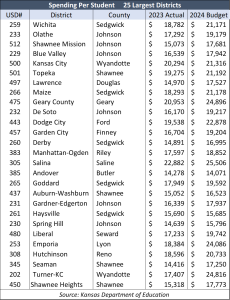New data from the Kansas Department of Education shows that school spending in the 2022-23 school year was $17,650 per student, with total spending at $8.2 billion. State aid accounts for $5.2 billion ($11,202 per student), federal aid is $1.1 billion ($2,327 per student), and local expenditures are $1.9 billion ($4,121 per student).
School spending for the previous school year was $7.9 billion, or $16,993 per student. Enrollment barely increased by 0.3% but is about 11,500 students below the pre-pandemic level in 2019.
 A review of the 25 largest districts based on enrollment shows spending ranging from a little over $14,000 per student for Andover to almost $24,000 in Salina. Andover has considerable enrollment in its virtual learning program, and funding for those students is much lower. Spring Hill is another district with a large virtual learning program.
A review of the 25 largest districts based on enrollment shows spending ranging from a little over $14,000 per student for Andover to almost $24,000 in Salina. Andover has considerable enrollment in its virtual learning program, and funding for those students is much lower. Spring Hill is another district with a large virtual learning program.
USD 500 Kansas City and USD 475 Geary County also spent more than $20,000 per student, while Topeka and Dodge City exceeded $19,000.
School spending data for each district is downloaded from the Department of Education website and tabulated by cost center across all funds. Per-student amounts are based on full-time equivalent enrollment.
Details on each district’s actual spending for FY 2023 can be found here on KansasOpenGov.org, and their budget reports are here.
School spending on Instruction, other cost centers
School spending is allocated across ten cost centers – Instruction, Student Support, Staff Support, Administration, Operations & Maintenance, Transportation, Food Service, Other Operating, Capital Outlay, and Debt Service. Total spending per student increased much more than inflation since 2005 (83% vs. 50%).
 The Department of Education Accounting Handbook says Instruction is “the most important part of the education program, the very foundation on which everything else is built. If this function fails to perform at the needed level, the whole educational program is doomed to failure regardless of how well the other functions perform.”
The Department of Education Accounting Handbook says Instruction is “the most important part of the education program, the very foundation on which everything else is built. If this function fails to perform at the needed level, the whole educational program is doomed to failure regardless of how well the other functions perform.”
In 2005, school districts allocated 54.4% of spending to Instruction ($5,259 out of $9,667); last year, Instruction accounted for only 52.5% of the total. After the Supreme Court ordered an $853 million funding increase in 2005, the Legislature passed a public policy statement, signed by Governor Kathleen Sebelius, calling on school districts to allocate 65% of total funding to Instruction. At the time, districts devoted 54.2% to Instruction. Last year’s allocation of 52.5% is the lowest portion spent on Instruction since then.
Had school districts followed the Legislature’s policy, $12.2 billion more would have been spent on Instruction since 2005.
$20,000 per student based on the cost of living
The Kansas Association of School Boards tries to downplay the amount of funding schools receive relative to other states, but Kansas is now in the top ten.
A dollar spent in Kansas buys a lot more than a dollar in New York or California, so the cost of living must be taken into account for comparison to other states. According to the Missouri Economic Research and Information Center (MERIC), Kansas has the fourth-lowest cost of living in the nation, at 87.4% of the national average.[i] Nominal spending of $17,650 per student is, therefore, the national equivalent of $20,195.
Kansas was #9 for COL-adjusted spending in 2021 and had the second-highest state aid per student on that basis. However, contrary to what many education officials claim, states that spend more do not have better outcomes.
Achievement in Kansas on the 2022 National Assessment of Educational Progress – the gold standard of comparing states – is below the national average. In fact, 31 states have the same or better NAEP composite as Kansas but spend less per student.
__________
[i] Index for the 3rd quarter of 2023





